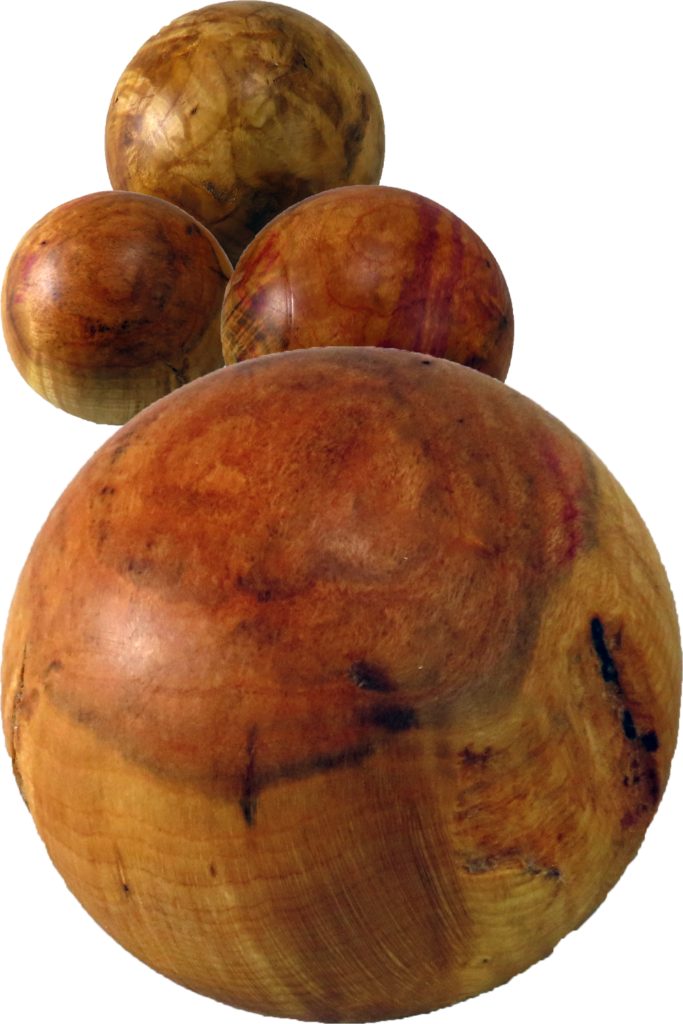Woodturning Perfect Spheres – For Wise Turners

For convenience, this video is also posted on YouTube, Vimeo, and FaceBook. Best place? – You are already here!
Whenever I see someone promote a sphere jig, a conflict boils up in me.
On one hand, I respect someone who can create a good jig and appreciate the apparatus.
On the other hand, a sphere jig is a terrible expense for most turners when the same result can be achieved in the same amount of time with typical tools and trivial expense. I would rather use my budget to purchase a good multi-purpose tool.
Well, I saw another and decided to again present the process to turn a perfect sphere without any expensive jig. This process combines the octagon method and cup centers. There sphere in this video took only 27 minutes from the cylinder stage to completed stage. I did not work quickly because I did not intend for it to be a race. However, after realizing how quickly the sphere turned, I am issuing a challenge.
The Challenge is in two parts: For turners who already have a jig and for turners who do not have a jig. For both groups, start when you have a cylinder of the chosen diameter.
Turners with a jig:
Using your jig – any jig – turn a sphere at your standard pace (not race speed) to completion and report your time. My time was 27 minutes to finished.
Turners without a jig:
Follow the process in this video. Turn a sphere at your standard pace (not race speed) to completion and report your times. An even better plan is to turn 3 spheres to cement the process in your brain and body.
Instead of blowing the budget on a special purpose tool, develop a basic skill to be used again and again in the future.
Enjoy!
spherejig #sphere #woodturning #woodlathe #turning #woodworking #AlanStratton #DIY #woodturningprojects #video #spheresfordummies
any chance you can list the critical numbers in your write up?
They are there in the explanation but here we go.
Top/Bottom of cylinder to corner = diameter times 0.293
All sides = diameter times 0.414.
Alan
Thanks for the sphere video. I think too much of woodturning is getting away from hand skills and simple math.
It takes time to learn the muscle memory of turning and a lot of people want the easy way out.
Fear can get in our way. But it can be conquered with a little courage and a process.
Alan
Alan, your comment that “…a sphere jig is a terrible expense for most turners when the same result can be achieved in the same amount of time with typical tools and trivial expense. I would rather use my budget to purchase a good multi-purpose tool” reminds me that there are several jigs, methods and products that can easily be improvised, thus avoiding unnecessary expense. Experienced turners should share these with their friends. One small example is to crush your flat-sided finish can (Danish Oil, wipe-on-poly, etc.) in your vise after each use, bringing the oil level to the top of the can to eliminate air in the can. No need to buy collapsible bags or inert gas aerosols.
Jigs make work easier and more repeatable – most of the time. But they are creations of our mind.
At one time, I also thought I needed a jig to turn a sphere. Fortunately, others showed me how easy I could do it with a minimum of jigging.
Alan
Just goes to show you. You don’t have to spend a lot of money to get good results.
Absolutely. Leave the machinery for when we really need it.
Alan
Alan, I have been using the shadow method to turn spheres up to 4” in diameter or so and have had pretty good results. Out of curiosity I decided to try your technique today and had similar good results with much less fussing around setting up illumination, centering the shadow table, drawing the “cut to” circle, and so on. Your technique makes it simple. Rather than trying to center the 0.414 x dia “cut to” line on the end of the cylinder it was easier to make the mark by just measuring from the edge of the cylinder toward the turning axis the same 0.293 x dia distance. Same mark but with one computation and one caliper setting. Thanks for pushing me to try a new technique!
Yes, First time comments are moderated. Afterwards, they show up as submitted.
I never would have thought to turn it the way you have described. Sounds ticky.
You are welcome.
Alan
Great presentation. A future program should be on what do we do with all the balls we have turned, rather then putting them in a large bowl.
When you are finished filling a large bowl, there are a lot of options that you will think of. 🙂
Alan